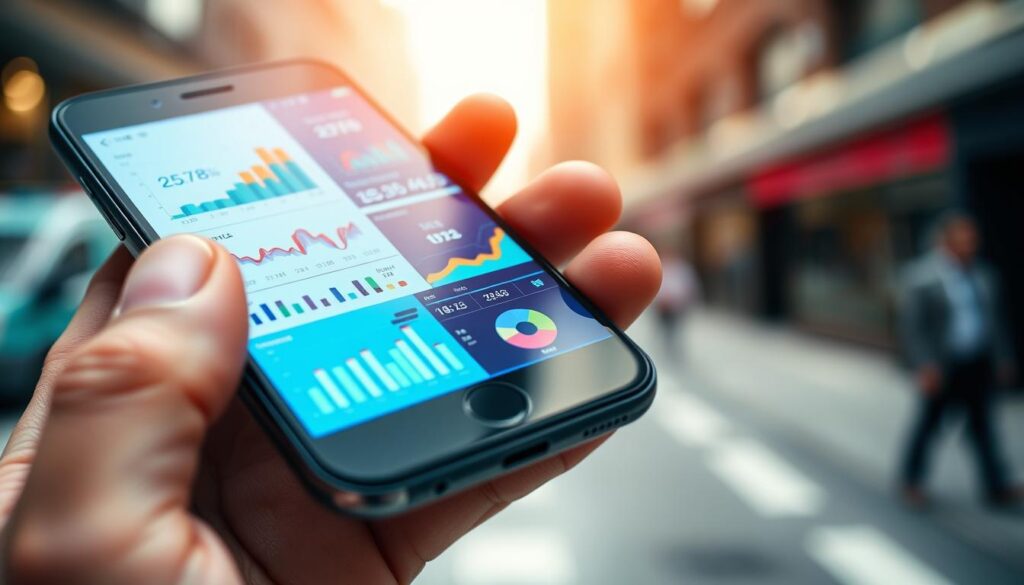As a data scientist, I’ve learned how vital it is to keep up with new trends and tech. Mobile devices make it easy to use apps for data analysis, coding, and learning. So, I’m excited to share the top apps for data scientists on the move.
Most people prefer using their phones for everyday tasks. Mobile apps can really help with learning. As a data scientist, I know how important the right tools are. That’s why I’ll talk about the best apps for data analysis, coding, and learning.
Now, over 80% of businesses use data science in their decisions. This shows data science is a lucrative field with a big demand. It’s key to have the right tools, like the best mobile apps for data scientists, to learn and grow.
Key Takeaways
- Mobile applications can enhance learning efficiency and provide access to various tools and resources for data analysis, programming, and learning.
- The best mobile apps for data scientists on the go include top data science apps and best apps for mobile data analysis.
- With over 90% of users preferring to use their phones for daily tasks, mobile applications are becoming increasingly popular among data scientists.
- More than 80% of businesses now incorporate data science into their decision-making processes, making it a high-paying sector with a low supply of professionals.
- The best mobile apps for data scientists can provide a complete learning experience and help users improve their data science and analytics skills.
- Access to the right tools and resources is essential for data scientists to stay ahead of the curve and advance their skills in data science and analytics.
Introduction to Data Science Mobile Apps
As a data scientist, I’ve learned how vital it is to have data scientist tools for mobile. These tools help with data analysis and processing. With so much data being created, having mobile productivity apps for data scientists is key. We’ll talk about why mobility matters and what to look for in data science apps for smartphones.
Data scientists should look for apps that are easy to use, offer data visualization, and have collaboration tools. Some top data science apps for smartphones include those with hands-on exercises and code-alongs in languages like Python, R, and SQL.
Here are some key features to look for in mobile productivity apps for data scientists:
- Ease of use
- Data visualization
- Collaboration tools
- Hands-on exercises and code-alongs
With these features, data scientists can work efficiently, even when away from their desks. The right data scientist tools for mobile let us analyze data, visualize insights, and work with our team. All from our smartphones.
| App | Features | Platforms |
|---|---|---|
| DataCamp | Hands-on exercises, code-alongs, data visualization | iOS, Android |
| Tableau | Data visualization, collaboration tools | iOS, Android |
Top Mobile Apps for Data Analysis
As a data scientist, it’s key to have mobile apps for data analysis. These apps help you stay productive and efficient. They offer features like data visualization, reporting, and tools for working together.
Apps like Tableau Mobile, Microsoft Power BI, and Google Sheets are among the best. They let you see and explore data anytime, anywhere. You can make interactive dashboards and reports to get insights and make decisions on the go.
- Data visualization and exploration
- Reporting and dashboard creation
- Collaboration and sharing tools
- On-the-go access to data and insights
| App | Features | Benefits |
|---|---|---|
| Tableau Mobile | Data visualization, dashboard creation | Interactive insights, on-the-go access |
| Microsoft Power BI | Reporting, data visualization, collaboration | Informed decision-making, increased productivity |
| Google Sheets | Data editing, collaboration, visualization | Real-time collaboration, data-driven insights |
Essential Programming Apps for Data Scientists
As a data scientist, it’s key to have programming apps for data analysis and processing. There are many best apps for mobile data analysis out there. For example, QPython lets users run Python scripts on their mobile devices. It includes a Python interpreter, console, editor, and SL4A Library for Android.
Some top data scientist tools for mobile are Jupyter Notebook, PyCharm, and RStudio. These apps have coding, debugging, and collaboration tools. Jupyter Notebook is great for coding and data analysis. PyCharm is a full-featured Python development environment. RStudio is for statistical computing and data analysis, with many packages for complex tasks.
For mobile productivity apps for data scientists, look for coding and debugging tools, collaboration features, and integration with other tools.
- Coding and debugging tools
- Collaboration and sharing features
- Integration with other data science tools and platforms

Using these essential programming apps, data scientists can work more efficiently. They can also keep up with the latest in their field.
| App | Features | Platforms |
|---|---|---|
| Jupyter Notebook | Interactive coding and data analysis | Android, iOS |
| PyCharm | Comprehensive development environment for Python | Android, iOS |
| RStudio | Statistical computing and data analysis | Android, iOS |
Machine Learning on Mobile
As a data scientist, I’ve seen how machine learning on mobile devices has changed data analysis. Apps like TensorFlow Lite and Weka let us build, test, and deploy models from our phones. These apps are key for data scientists who are always on the move.
Using data science apps on smartphones lets us learn and practice machine learning anytime, anywhere. TensorFlow Lite helps us build and test models on our phones. Weka offers a platform for building and testing models with different algorithms. This way, we can keep up with machine learning news, even when we’re not at our desks.
Some big benefits of using machine learning on mobile include:
- Increased accessibility: Machine learning apps can be used anywhere, anytime, making it possible for data scientists to work on projects remotely.
- Improved productivity: With the help of machine learning apps, data scientists can automate many tasks, freeing up time to focus on more complex projects.
- Enhanced collaboration: Machine learning apps can be used to collaborate with colleagues and share models and results, making it easier to work on team projects.

Overall, machine learning on mobile devices is changing data science. It lets us build, test, and deploy models anywhere, anytime. By using top apps like TensorFlow Lite and Weka, we can stay current with machine learning advancements.
Data Visualization Tools for Rapid Insights
As a data scientist, I’ve learned how vital data visualization apps for mobile are. They help us get quick insights and make smart choices. Being able to analyze and see data anywhere is key to my work.
The best mobile apps for data crunching include Datawrapper and Chartblocks. They have features that meet different needs. Datawrapper is easy to use and versatile. Chartblocks stands out for its customization and advanced analytics.
For mobile apps for on-the-go data analysis, there are many choices. Tableau, Power BI, and Google Charts are popular. They offer great features that you can use anytime, anywhere.
Here’s a table showing some top data visualization tools’ features and prices:
| Tool | Features | Pricing |
|---|---|---|
| Datawrapper | Easy to use, versatile, and customizable | Free plan available, with premium plans starting at $15/month |
| Chartblocks | Advanced analytics, customization options, and real-time data updates | Premium plans starting at $29/month |
| Tableau | Drag-and-drop functionality, extensive visualization options, and real-time data analysis | Premium plans starting at $35/month |
Using these tools, data scientists and analysts can quickly get insights and make informed decisions. This is true no matter where they are or what device they use.
Productivity Apps for Data Scientists
As a data scientist, the right productivity apps can make a big difference. They help manage projects, talk to team members, and analyze data on the move. Apps like Trello and Slack make tasks simpler and boost productivity.
Apps for mobile data analysis, such as Todoist and Sunsama, help keep tasks organized. They sync across devices, so you can access your work anywhere. For example, researchers can use these apps to work better together.
Apps like Notion and Paste offer customizable templates and clipboard management. This helps with project notes and tracking. Most of these apps are free or very cheap, making it easy to find what you need. Using these apps, data scientists can work more efficiently and get better results.
By using these mobile tools, data scientists can work better together and more efficiently. The right apps help stay organized and focused. This leads to better work outcomes.
Conclusion: Choosing the Right Apps for Your Needs
The world of mobile apps for data scientists is vast and always changing. From data visualization tools to powerful programming environments, the right apps are key to your success. It’s important to pick the best apps for your needs and keep up with new tech.
Look for apps that integrate data well, are easy to use, and support teamwork. Tools like Tableau Mobile, Microsoft Power BI, and Google Sheets are great for analyzing and sharing data on the move. Apps like Jupyter Notebook, PyCharm, and RStudio let you code and develop models from anywhere.
The need for data-driven decisions is growing fast. The best mobile apps for data scientists will become even more important. By choosing the right tools, you can boost your productivity, teamwork, and insights. This will put you at the leading edge of the data science world.

